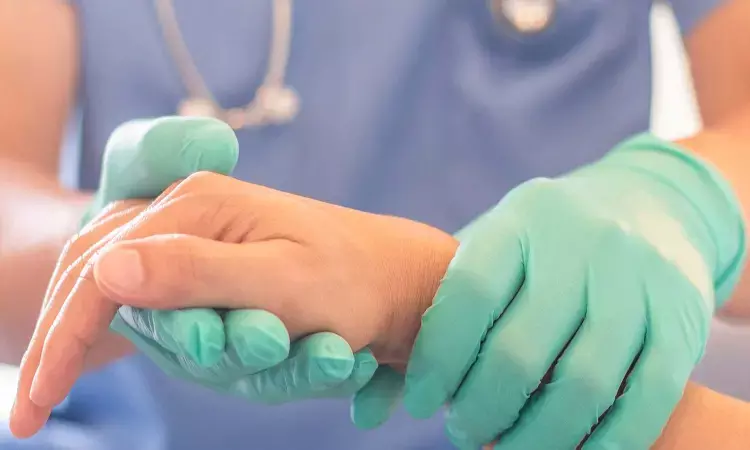- Home
- Medical news & Guidelines
- Anesthesiology
- Cardiology and CTVS
- Critical Care
- Dentistry
- Dermatology
- Diabetes and Endocrinology
- ENT
- Gastroenterology
- Medicine
- Nephrology
- Neurology
- Obstretics-Gynaecology
- Oncology
- Ophthalmology
- Orthopaedics
- Pediatrics-Neonatology
- Psychiatry
- Pulmonology
- Radiology
- Surgery
- Urology
- Laboratory Medicine
- Diet
- Nursing
- Paramedical
- Physiotherapy
- Health news
- Fact Check
- Bone Health Fact Check
- Brain Health Fact Check
- Cancer Related Fact Check
- Child Care Fact Check
- Dental and oral health fact check
- Diabetes and metabolic health fact check
- Diet and Nutrition Fact Check
- Eye and ENT Care Fact Check
- Fitness fact check
- Gut health fact check
- Heart health fact check
- Kidney health fact check
- Medical education fact check
- Men's health fact check
- Respiratory fact check
- Skin and hair care fact check
- Vaccine and Immunization fact check
- Women's health fact check
- AYUSH
- State News
- Andaman and Nicobar Islands
- Andhra Pradesh
- Arunachal Pradesh
- Assam
- Bihar
- Chandigarh
- Chattisgarh
- Dadra and Nagar Haveli
- Daman and Diu
- Delhi
- Goa
- Gujarat
- Haryana
- Himachal Pradesh
- Jammu & Kashmir
- Jharkhand
- Karnataka
- Kerala
- Ladakh
- Lakshadweep
- Madhya Pradesh
- Maharashtra
- Manipur
- Meghalaya
- Mizoram
- Nagaland
- Odisha
- Puducherry
- Punjab
- Rajasthan
- Sikkim
- Tamil Nadu
- Telangana
- Tripura
- Uttar Pradesh
- Uttrakhand
- West Bengal
- Medical Education
- Industry
TENS and tPCS combo Improves lower limb spasticity in spastic cerebral palsy: Study

According to recent research, it has been found out that combination of transcranial pulsed current stimulation (tPCS) and transcutaneous electrical nerve stimulation (TENS) can significantly improve lower limb spasticity in spastic cerebral palsy (SCP) children, as published in the BMC Pediatrics.
In the current study, the authors, Zhenhuan Liu and colleagues from the Department of Pediatric Rehabilitation, Nanhai Maternity and Children's Hospital Affiliated to Guangzhou University of Traditional Chinese Medicine, Foshan, Guangdong Province, China applied a combination of non-invasive neuromodulation modalities concurrently with multiple stimulating electrodes.
Specifically, they used transcranial pulsed current stimulation (tPCS) and transcutaneous electrical nerve stimulation (TENS) as a novel strategy for improving lower limb spasticity in children with spastic cerebral palsy (SCP) categorized on levels III–V of the Gross Motor Function Classification System (GMFCS) with minimal side effects.
Sixty-three SCP children aged 2–12 years, who were classified on levels III–V of the GMFCS were randomly assigned to one of two groups, resulting in 32 children in the experimental group and 31 children in the control group.
The experimental group underwent a combination therapy of tPCS (400 Hz, 1 mA cerebello-cerebral stimulation) and TENS (400 Hz, max 10 mA) for 30 min, followed by 30 min of physiotherapy five times per week for 12 weeks.
The control group underwent physiotherapy only 30 mins per day five times per week for 12 weeks. In total, all groups underwent 60 treatment sessions. The primary outcome measures were the Modified Ashworth Scale (MAS) and Modified Tardieu Scale (MTS). Evaluations were performed 3 days before and after treatment.
The key findings derived were-
- There was a significant improvement in MAS and MTS scores of the lower limbs in the experimental group compared to the control group in the hip adductors (Left: p = 0.002; Right: p = 0.002), hamstrings (Left: p = 0.001; Right: p < 0.001, and gastrocnemius (Left: p = 0.001; Right: p = 0.000).
- Moreover, MTS scores of R1, R2 and R2-R1 in left and right hip adduction, knee joint, and ankle joint all showed significant improvements (p ≤ 0.05).
- Analysis of MAS and MTS scores compared to baseline scores showed significant improvements in the experimental group but declines in the control group.
Therefore, it was concluded that "a combination of tPCS and TENS can significantly improve lower limb spasticity in SCP children classified on GMFCS levels III–V with minimal side effects, presenting a novel strategy for addressing spasticity challenges in children with severe SCP."
Dr. Nandita Mohan is a practicing pediatric dentist with more than 5 years of clinical work experience. Along with this, she is equally interested in keeping herself up to date about the latest developments in the field of medicine and dentistry which is the driving force for her to be in association with Medical Dialogues. She also has her name attached with many publications; both national and international. She has pursued her BDS from Rajiv Gandhi University of Health Sciences, Bangalore and later went to enter her dream specialty (MDS) in the Department of Pedodontics and Preventive Dentistry from Pt. B.D. Sharma University of Health Sciences. Through all the years of experience, her core interest in learning something new has never stopped. She can be contacted at editorial@medicaldialogues.in. Contact no. 011-43720751
Dr Kamal Kant Kohli-MBBS, DTCD- a chest specialist with more than 30 years of practice and a flair for writing clinical articles, Dr Kamal Kant Kohli joined Medical Dialogues as a Chief Editor of Medical News. Besides writing articles, as an editor, he proofreads and verifies all the medical content published on Medical Dialogues including those coming from journals, studies,medical conferences,guidelines etc. Email: drkohli@medicaldialogues.in. Contact no. 011-43720751


